Learn how to make flaky vegan pie crust! This easy homemade vegan pie crust recipe is every bit as flaky, tender, and buttery as the pie crust we used to make with dairy butter, in fact, we think it’s better. It’s made with simple ingredients and makes enough for two pie crusts.
Published on Nov. 23, 2015 and updated April 27, 2021.

Jump to:
- Sweet and savory vegan pie recipes you’ll love
- Ingredients and substitution
- Pro tips and frequently asked questions
- How to make a vegan pie crust from scratch
- How to roll a pie crust
- How to blind bake a pie crust
- How to make a lattice top with pie dough
- Storage/freezing
- What to do with leftover pie dough
- How to Make Flaky Vegan Pie Crust
Sweet and savory vegan pie recipes you’ll love
Classic Vegan Banana Cream Pie
Vegan Lemon Meringue Pie with Aquafaba
Ingredients and substitution
Vegan Butter – Earth Balance buttery sticks is by far the best for making pie crust. We’ve tried using other vegan brands, and found that they’re either too dry (which makes a crust that cracks when it rolls out) or too oily.
Vegan Shortening – This is a must for making flaky pie crust that holds its shape. We use Crisco vegetable shortening, although you can use whatever brand you like.
All-Purpose Flour – We’ve tried using an all-purpose gluten-free flour to make pie crust, and it turned out dry and crumbly. We’re working on one with almond flour, so stay tuned.
Sugar – A small amount of sugar helps to make the crust tender because it interferes with the development of gluten. You can leave it out if you want, although we think it makes the crust better.
Salt – A small amount of salt enhances the flavor of the crust and makes it taste better.
Ice Water – Cold water prevents the fat from softening when you mix and knead the dough together. The reason you don’t want the butter to melt is because the water in the butter interferes with the gluten, resulting in a less than flaky pie crust.

Pro tips and frequently asked questions
Use vegan butter AND shortening. Using both will make the pie crust flaky and tender
Cube the butter and shortening before chilling. Cubing it helps it break down quicker so it stays chilled.
Freeze the plant-based butter and shortening for 10 to 15 minutes so it gets super chilled. If the fat is warm, the crust will not turn out as well.
Use a silicone rolling mat. This will help you measure the size of the pie crust and make cleanup easy.
Ice water is key for making flaky crust because it keeps the fat chilled. Add a little extra if the pie dough is dry and crumbly.
Wrap it in plastic wrap and chill for one hour before rolling it out. Again, the fat needs to be chilled for the best result.
If you chill it for more than an hour you may find that it’s hard to roll out. In that case, let it sit out on the countertop for 15 minutes and try again.
If you need to freeze it, roll it out, place it in the pan that you’ll bake it in, and wrap it in a freezer safe container for up to 3 months. Don’t freeze the ball of dough.
How to make a vegan pie crust from scratch
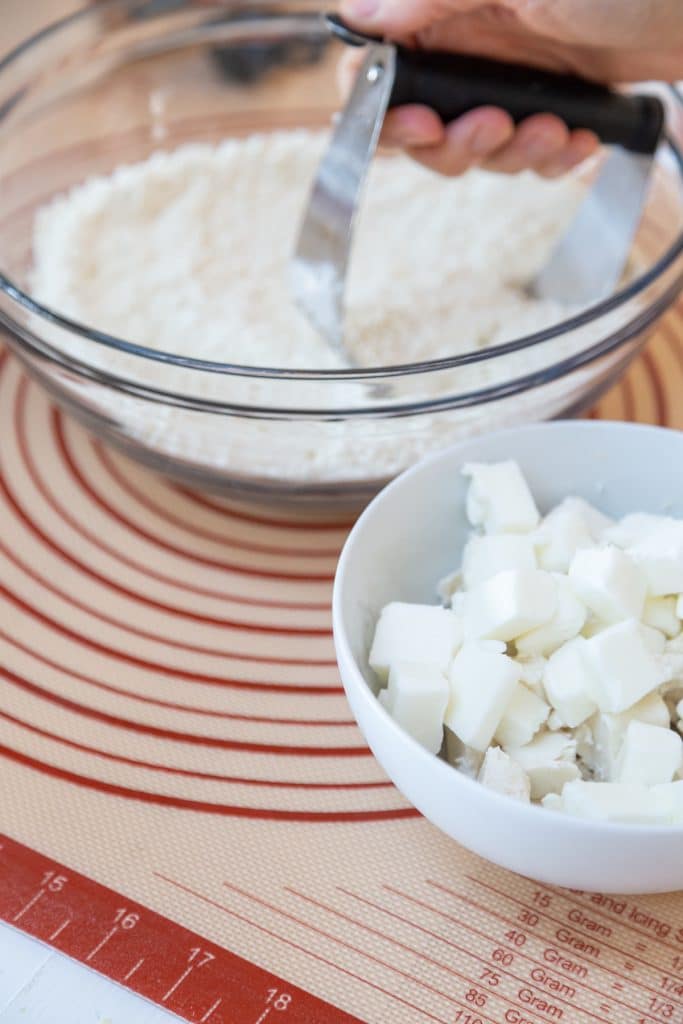
STEP ONE
Cube the butter and shortening and then place in the freezer for 10 to 15 minutes so it gets nice and cold.
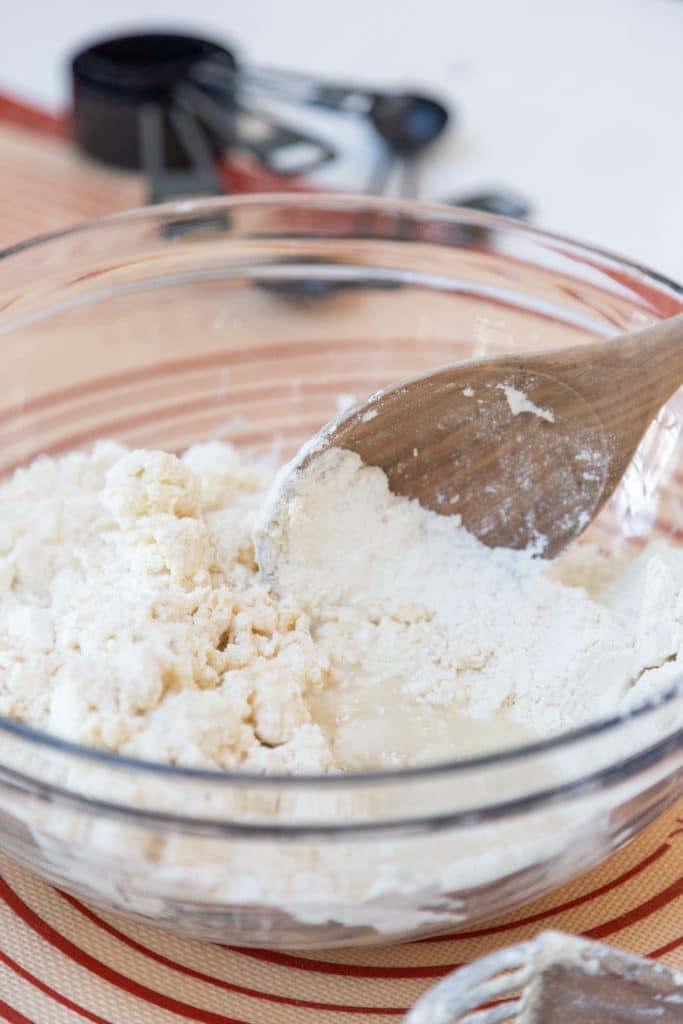
STEP TWO
In a large mixing bowl, whisk the dry ingredients and the vinegar until well combined.

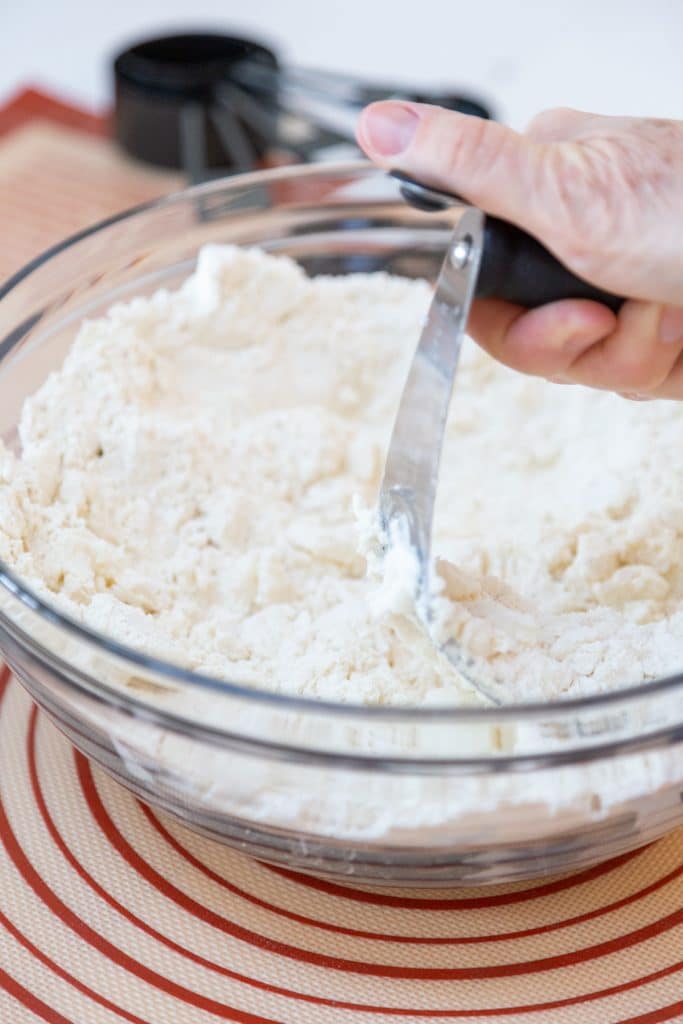
STEP THREE
Cut the butter and shortening into the flour mixture with a pastry cutter.
The fat should look like pebbles in sand when it’s ready.
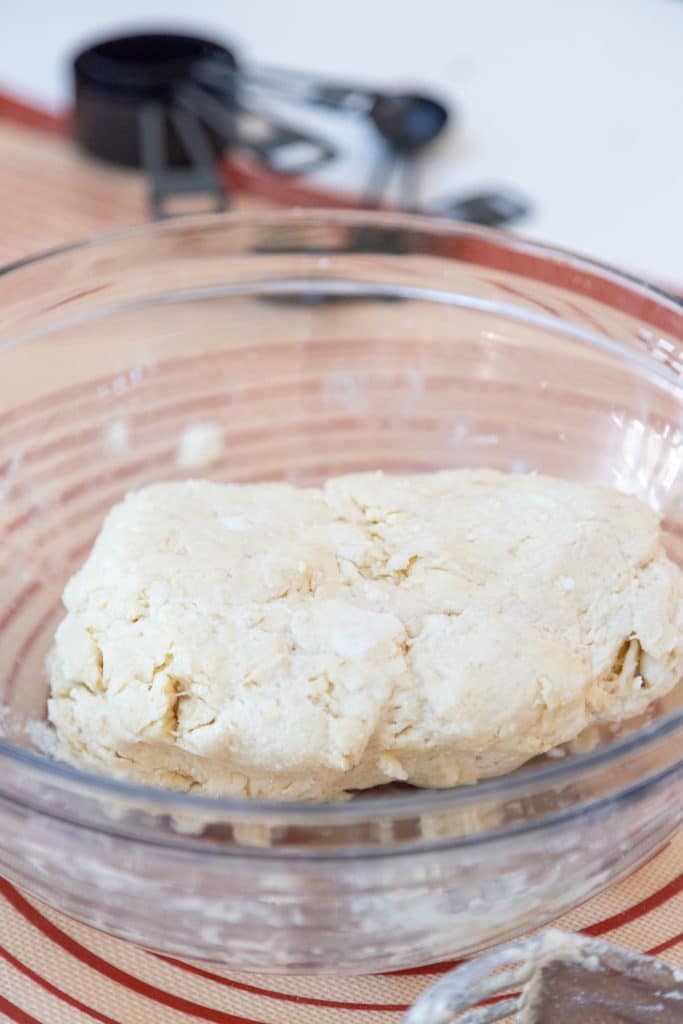
STEP FOUR
Add one tablespoon of ice water at a time and stir until the dough forms a ball. It shouldn’t be dry and crumbly or too wet and sticky.
The dough should be tacky to the touch, just a slight stickiness.
STEP FIVE
On a lightly floured surface, gently knead the 2 or 3 times, then fold in half, pat, and knead 2 more times and roll into a ball.
Wrap it in plastic and chill in the refrigerator for an hour.
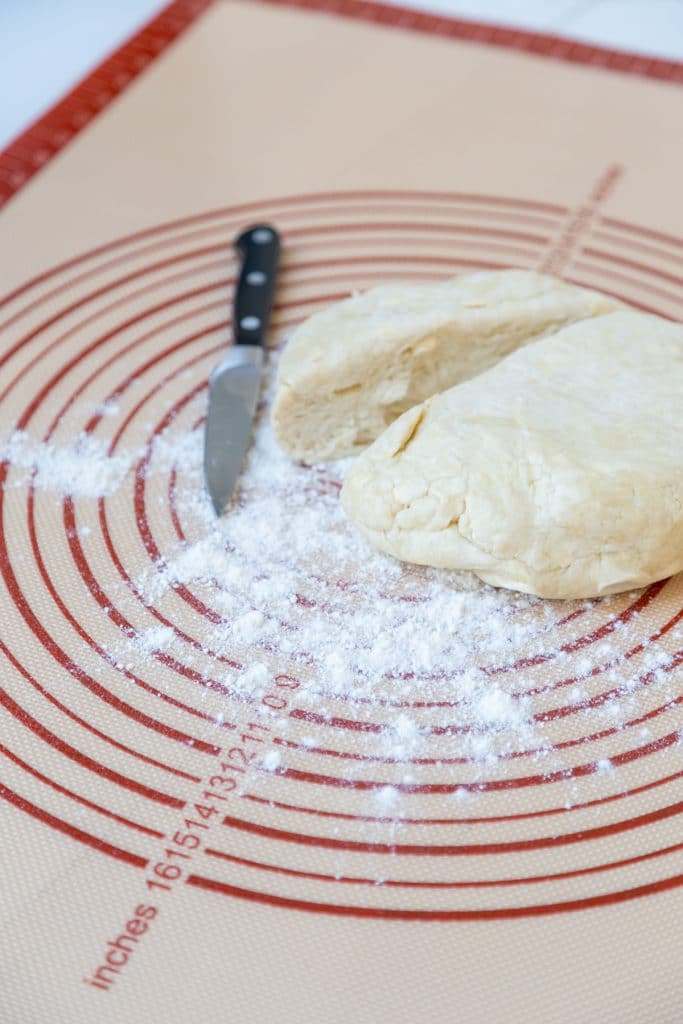
How to roll a pie crust
Rolling out pie dough is easy if you follow these simple rules.
Lightly flour a smooth surface, such as marble, or use a silicone pie mat. Don’t use a wooden board or anything with texture or it will stick.
Lightly flour the rolling pin.
Pat the dough into a disc and roll from the center out, turn the dough and continue rolling from the center out until the circle of dough is approximately ⅛ of an inch thick (about the width of 2 stacked quarters) and the correct size for the pie pan.
Place the top of the pie pan over the rolled-out dough, it should be about 2 inches wider than the pan.
Lightly flour the rolling pin once more and then gently roll the dough onto the rolling pin, place it on the edge of the pan with about an inch of overhang, and unroll it over the pan.
Trim the dough along the outside edge of the pie pan and crimp the edge of the dough.
Place the dough in the freezer for 30 minutes before blind baking or filling and baking. This will prevent the crust from shrinking and ensure that the fat is chilled for a flakier pie crust.
How to blind bake a pie crust
If you’re making a pie that doesn’t require baking the filling, such as a lemon meringue pie, you’ll want to blind bake the crust.
Preheat the oven to 350˚F (176˚C) and fill the bottom of the crust with pie weights. If you don’t have those, line the bottom of the crust with parchment paper and cover with dried beans. This will prevent the bottom from forming bubbles and shrinkage.
Bake the crust for approximately 40 minutes, or until it’s a light golden brown.
If the edges start to brown too much before the bottom of the pie crust, carefully cover with foil or pie crust shields.

How to make a lattice top with pie dough
Roll the dough in a circle, approximately ⅛ of an inch thick, then use a sharp knife to slice strips of dough. They should all be the same width.

Place the longest strips of dough over the center of the pie, like this.

Take the next longest strip of dough and lay it over the top of one of the strips and then place another strip in the opposite direction. Gently lift the bottom strip to layer. Like this.
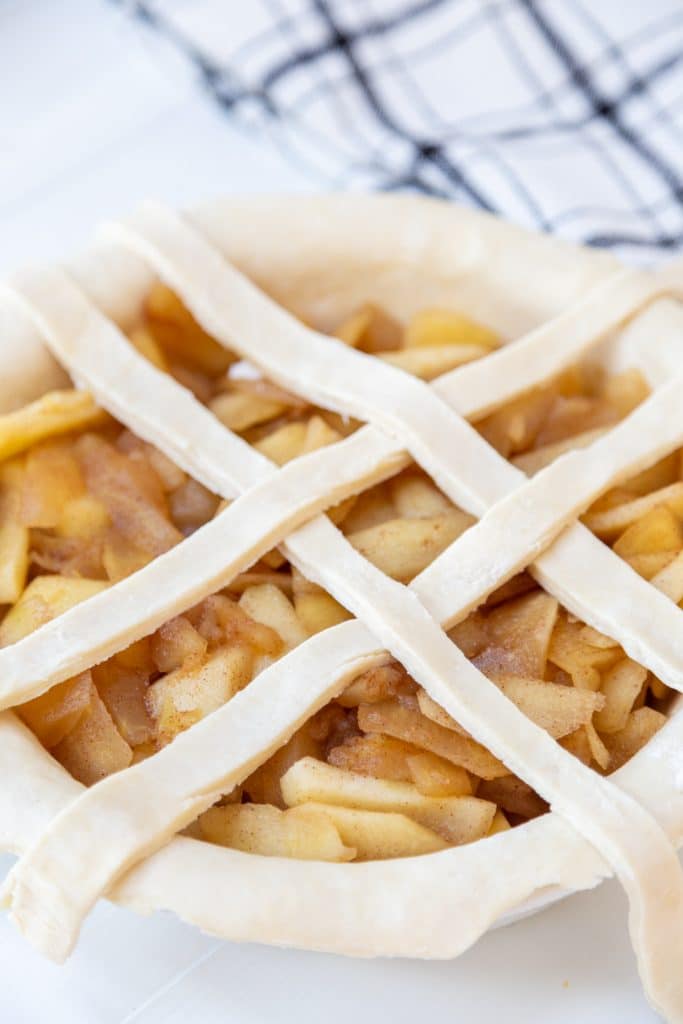
Continue the process (largest to smallest as you move from the center to the ends of the pie).

Storage/freezing
Wrap the dough in plastic wrap and store in the refrigerator for up to 2 days. Let it warm up for about ten to fifteen minutes if it’s difficult to roll out.
To freeze, roll it out and put it in the pie pan, place in a freezer safe container or cover for up to 3 months.
What to do with leftover pie dough
If you want to make a really decorative pie, roll out the extra dough and use cookie cutters to decorate the top, like we did with our pumpkin pie.
You can also make cinnamon sugar pie crust chips and use them to dip into a sweet sauce.
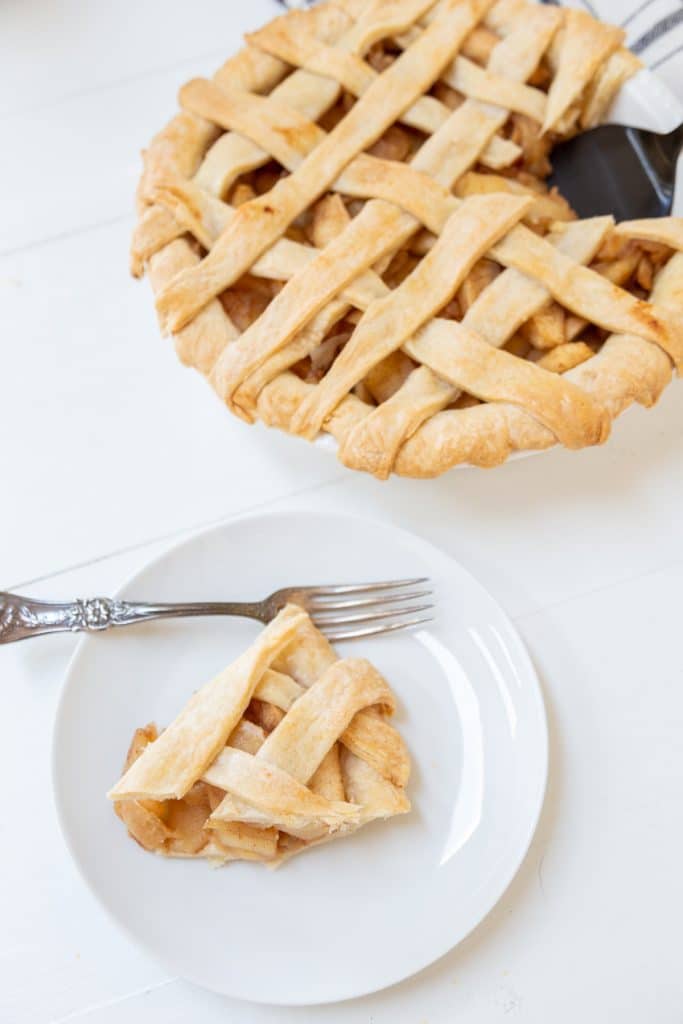

How to Make Flaky Vegan Pie Crust
Equipment
- Pie dough cutter
Ingredients
- 10 tablespoon vegan butter, chilled I use Earth Balance
- 8 tablespoon vegan shortening, chilled I use Earth Balance SEE NOTE
- 3 cups all-purpose flour plus extra for dusting the rolling surface
- 1 tablespoon sugar
- ½ teaspoon salt
- 1 teaspoon apple cider vinegar
- 6-10 tablespoon ice water
Instructions
- Cut the butter and shortening into small cubes, put them in a bowl and place them in the freezer while you’re measuring out the rest of the ingredients.
- Whisk the 3 cups of all-purpose flour, 1tbsp of sugar, salt, and 1 teaspoon of vinegar in a large mixing bowl.
- Add the chilled butter and shortening and cut it into the flour with a pastry cutter. It will look like pebbles in sand when it’s ready.
- Stir in one tablespoon of ice water at atime until the dough starts to form a ball and is slightly sticky to the touch.It should be a little tacky, not dry and crumbly, and not so wet that it sticksto your hands.
- Remove the dough from the bowl and knead into a disc on a floured surface. Fold the disc in half and knead. Repeat one or two more times until the dough sticks together in a ball. Cover with plastic wrap and refrigerate for an hour.
- Break the dough in half and roll one half of the dough out on a floured surface. Lightly flour the top of the dough and the rolling pin. Pick up the dough and turn it and continue the process until it’s large enough to cover the pie pan.
- Place the bottom layer of crust in the pie pan and trip the excess ends off.
- If you need to make a top for the pie, rollout the second half of the dough and cover the filling of the pie with the top.Cut a few slits in the crust to allow steam to escape.
- Bake according to the pie instructions.Brush a light layer of olive oil and sprinkle sugar on top of the crust for the last ten minutes of baking for a nice golden color.
- Enjoy!



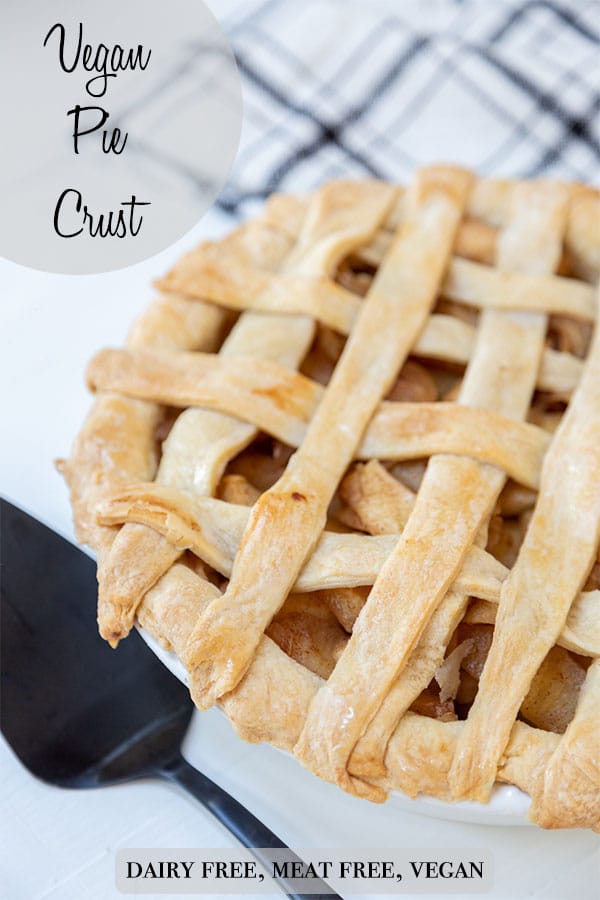

Genevieve says
This is the best pie crust I’ve ever made (including pies I baked before becoming vegan)! It was easy and delicious and flaky and held together beautifully.
Linda Meyer says
Thank you so much, Genevieve! We're so happy you liked it, and appreciate that you took the time to let us know. 🙂
kate s. says
i like this recipe and have made it several times. it seems the youtube video has gone kaput!
Linda Meyer says
Hi Kate! Thank you so much, we're happy you like it. Yes, we're in the process of updating our old videos. We'll have a new one up in the next few months. 🙂
Lori says
Can you make this gluten free?
Linda Meyer says
Hi Lori, unfortunately we haven't had any luck using gluten-free flour. The crust always turns out tough and crumbly.
Kat says
Hi! Maybe I've missed it, but how long do I cook the crust for?
Linda Meyer says
Hi Kat, it depends on the pie that you're baking. If you're only baking the crust, then we suggest lining the bottom with a layer of parchment paper and evenly cover with dried beans. This will prevent the bottom of the crust from bubbling. Bake it in a 350F oven for approximately 40 minutes, or until it's a golden brown. Thanks for your great question. Will update the recipe card to include this note.
Julie says
Love this recipe! made it many times with country crock butter. For those of you who have used country crock you need less water (I normally used 4-6 tablespoons) first time ever doing earth butter, used 9 tablespoons but I think next time I'll do 10.
Linda Meyer says
Thank you, Julie! We're so happy you like it, and appreciate your detailed information about the butter. It's so important to realize that every brand will yield a different result, especially when it comes to baking. You're awesome!
Amanjit says
Thank you for this recipe! This is now my go-to pie crust... and I'm no expert baker.
Here in Australia, the only shortening I could find was 'Copha', a rock-hard hydrogenated block available in most supermarkets. I'm not such a fan of hydrogenated fats, but on special occasions, health rules go out the window!
Anyway, the little cubes of Copha didn't work well in the mixer. I *did* want tiny pieces of Copha left behind, because those tiny pieces of shortening are the trick to achieving that 'flaky' crust. But my weak-ass mixer left behind full-size pieces of Copha - too big! - so I threw the dough in the food processor for a bit. As a result, the dough was slightly over-worked (the gluten in the flour started developing and being more stretchy), but it still turned out beautiful and delicious.
Time time, I'll go straight to the food processor when I'm using Copha, rather than use both the mixer and the processor. And hopefully, the dough will be more 'short' and less 'gluteny' (if that makes sense) and will be even more perfect.
Thank you for this amazing, forgiving, delicious recipe. 🙂
Linda Meyer says
Hi Amanjit! Thank you for taking the time to let us know. Yes, we can imagine how frustrating that must have been. Good on you for not giving up!! 🙂 As you probably know, you could have used all vegan butter, but it would have been less flaky because shortening has more fat, and you need that to create the flaky pockets.
We are with you on the hydrogenated oils. YUCK! Although, like you said, sometimes special occasions call for letting go and eating it. LOL!
Madhvi says
Would it be possible to use all vegetable shortening instead? I couldn't find any vegan butter at the grocery store today.
Linda Meyer says
We haven't tried it, so we can't be sure that it would work out. We like to use the mix because of the flavor of the butter. Shortening has a lot more fat in it, which is why we use both. If you try it, please let us know how it turned out. 🙂
Madhvi says
Just tried it out and it was delicious! Super flaky! But I think I added too much shortening so I would recommend using less. Maybe around 250 grams or less?
Linda Meyer says
Excellent! Thanks for letting us know. 🙂
Amy says
I could not roll this out to save my life. I eventually gave up and just pressed it into the pie plate. Guess what though? Turned out delicious! (albeit a bit ugly). The baked crust is truly the best pie crust I've even tried vegan or not.
Linda Meyer says
Hi Amy, I'm sorry that it didn't roll out for you. We've never had that problem. Sometimes, if it's too cold, you might need to let it sit for a while before rolling, other than that I can't figure out why it didn't roll out. Having said that, I'm happy it was good. LOL! Thank you so much for taking the time to let us know.
K says
I’ve had this recipe pinned on Pinterest for months waiting to try it, I’m finally making it today! But I couldn’t find shortening so would all butter still work?
Linda Meyer says
Hi! Thank you so much! I ran into the exact same issue this week so I can confidently tell you that you can use all vegan butter to make the crust. I'm going to put a note in the recipe now. Enjoy!
K says
Turned out great and was a success with everyone!
Thanks so much.
Linda Meyer says
So good to hear! Thanks for letting us know. We made three batches of crust just today. 🙂 Have a happy Thanksgiving.
Laura says
What are the exact amounts of vegan butter and shortening? Thank you!
Linda Meyer says
Hi Laura, One stick of Earth Balance is approximately 7 tablespoons, so you would use 7 tablespoons of vegan butter and 3 and 1/2 to four (either one will work) of vegan shortening. Thanks for asking.
Bridgett says
I should have read this comment before proceeding with the recipe bc mine came out like cake batter. From what I found online, 1 veg shortening stick is usually equal to 1 cup (16 tbsp.) and 1 stick of butter is usually 1/2 c. (8 tbsp.) so I used those measurements. Back to the drawing board.
Linda Meyer says
Hi Bridgett, I'm sorry your crust didn't work out. I'm not sure that 4 more tbsp of shortening or butter would have made the dough turn out like cake batter. It sounds like maybe there was too much water added to the dough. Add 1 tbsp at a time until it forms a solid ball. Sometimes I need to add 6 and other times 10, it depends on the flour. I hope you try this recipe again because it's such a tender and flaky crust. Have a wonderful Thanksgiving!
Bridgett says
Hi Linda, I just remade it the way you told the lady above with 11 tbsp and it worked out great. My previous dough turned out like cake batter before I used 1 c butter and 1 c veg shortening (32 tbsp), since those are standard measuring when using sticks and was wondering why there was so much more than the other crusts ive made. lolol Thank you =)
Linda Meyer says
Yay! I'm so happy it worked. Cooking, especially baking, is a science. One error and it's ruined. Enjoy! 🙂